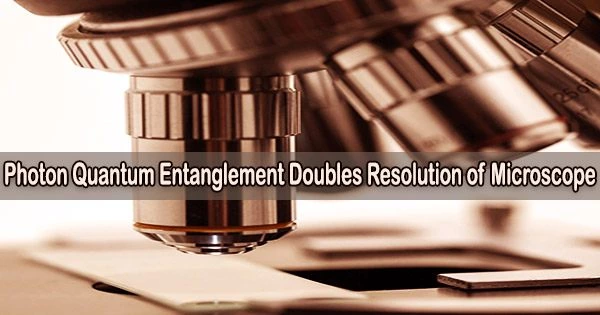Caltech researchers have found a way to enhance the resolution of light microscopes using a “spooky” quantum physics phenomena.
A team led by Lihong Wang, Bren Professor of Medical Engineering and Electrical Engineering, demonstrates the advancement of microscopy through the phenomenon known as quantum entanglement in research that will be published in the journal Nature Communications.
A phenomenon known as quantum entanglement occurs when two particles are connected in such a way that their states are inextricably linked, regardless of how far apart they are from one another. Albert Einstein famously referred to quantum entanglement as “spooky action at a distance” because it could not be explained by his relativity theory.
According to quantum theory, any type of particle can be entangled. The entangled particles in Wang’s novel microscopy method, known as quantum microscopy by coincidence (QMC), are photons. A biphoton is a pair of entangled photons that behaves somewhat like a single particle with twice the momentum of a single photon. This behavior is crucial for Wang’s microscopy.
Given that all particles in quantum mechanics are also waves and since the wavelength of a wave is inversely proportional to the particle’s momentum, particles with higher momenta have shorter wavelengths. So, because a biphoton has double the momentum of a photon, its wavelength is half that of the individual photons.
This is key to how QMC works. Only objects whose minimum size is half the wavelength of the light used by the microscope can have their features imaged by a microscope. The wavelength of that light can be shortened, allowing the microscope to observe even minute details with greater resolution.
The wavelength of light utilized in a microscope can be shrunk without using quantum entanglement. For instance, the wavelength of green light is shorter than that of red light, while the wavelength of purple light is shorter than that of green light. But due to another quirk of quantum physics, light with shorter wavelengths carries more energy.
So, once you get down to light with a wavelength small enough to image tiny things, the light carries so much energy that it will damage the items being imaged, especially living things such as cells. This is why ultraviolet (UV) light, which has a very short wavelength, gives you a sunburn.
QMC gets around this limit by using biphotons that carry the lower energy of longer-wavelength photons while having the shorter wavelength of higher-energy photons.
“Cells don’t like UV light,” Wang says. “But if we can use 400-nanometer light to image the cell and achieve the effect of 200-nm light, which is UV, the cells will be happy, and we’re getting the resolution of UV.”
In order to do that, Wang’s team created an optical device that beams laser light into a certain form of crystal, causing some photons to travel through it to become biphotons. Even with the use of this unique crystal, just one out of every million photons undergoes the conversion.
Using a series of mirrors, lenses, and prisms, each biphoton which actually consists of two discrete photons is split up and shuttled along two paths, so that one of the paired photons passes through the object being imaged and the other does not. The photon passing through the object is called the signal photon, and the one that does not is called the idler photon.
These photons then pass via additional optics before arriving at a detector attached to a computer, which uses the data contained by the signal photon to create an image of the cell. Amazingly, despite the existence of the item and their distinct routes, the paired photons continue to be entangled as a biphoton acting at half the wavelength.
Wang’s lab was not the first to work on this kind of biphoton imaging, but it was the first to create a viable system using the concept. “We developed what we believe a rigorous theory as well as a faster and more accurate entanglement-measurement method. We reached microscopic resolution and imaged cells.”
While there is no theoretical limit to the number of photons that can be entangled with each other, each additional photon would further increase the momentum of the resulting multiphoton while further decreasing its wavelength.
Wang says future research could enable the entanglement of even more photons, although he notes that each extra photon further reduces the probability of a successful entanglement, which, as mentioned above, is already as low as a one-in-a-million chance.
The paper describing the work, “Quantum Microscopy of Cells at the Heisenberg Limit,” appears in the April 28 issue of Nature Communications. Co-authors are Zhe Heand Yide Zhang, both postdoctoral scholar research associates in medical engineering; medical engineering graduate student Xin Tong (MS ’21); and Lei Li (PhD ’19), formerly a medical engineering postdoctoral scholar and now an assistant professor of electrical and computer engineering at Rice University.
The Chan Zuckerberg Initiative and the National Institutes of Health provided funding for the research.





